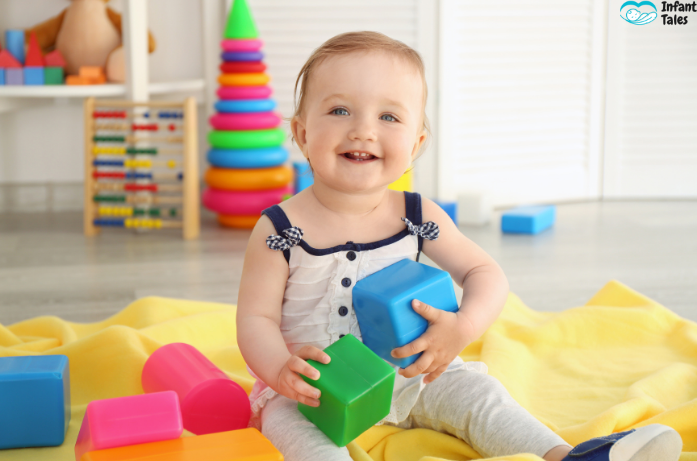Written by a caring mom at Infant Tales, inspiring joyful, everyday learning for children.
Preschoolers are little bundles of curiosity, always asking, touching, exploring, and experimenting. The world is their classroom, and every experience becomes a lesson. As parents and caregivers, we play a vital role in nurturing that natural curiosity through playful learning experiences that make education feel like fun rather than work. The best part is, you don’t need expensive toys or fancy setups to encourage learning.
With a little creativity, your home can easily become an exciting space for discovery where preschoolers develop early literacy, math, motor, and social skills through everyday play. In this guide, we’ve compiled 25 fun and easy preschool learning activities that are educational, engaging, and simple to set up using household materials, perfect for ages 3–5 and adaptable for every learning stage.
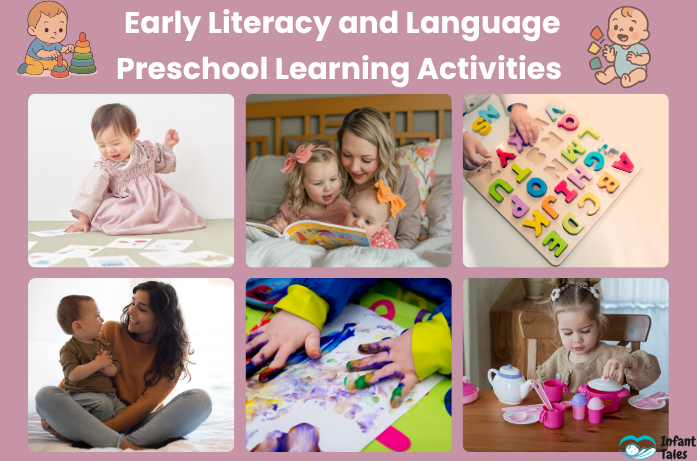
Early Literacy and Language Preschool Learning Activities
Preschool learning activities in the field of early literacy and language have a great deal to do with the child’s future strong communication skills, vocabulary, and imagination. Children will soon realize how close words and ideas are through reading, stories, and sound games.
1. Alphabet Treasure Hunt
Hide alphabet cards or magnetic letters around your home. Each time your child finds one, ask them to say the letter and its sound. You can also have them find objects that begin with that letter. This builds letter recognition and sound awareness.
2. Interesting Story Time
Let your child’s favorite story be read out loud. Asked questions such as “What do you think will happen next?” or “Why did the character do that?” when there are pauses. The joint act of acting out scenes enhances the child in terms of listening, comprehension, and creativity.
3. Collage Name Craft
One good way is to make your child’s big name in capital letters and assist him/her to put stickers or different colors for each letter. This activity helps children in recognizing their names and developing fine motor coordination since it is hands-on and children get to participate actively.
4. Sing Nursery Rhymes
Classic rhymes such as The Wheels on the Bus or Twinkle, Twinkle, Little Star are great for early language learning. While singing, kids are getting to hear the music thus developing memory, rhythm, and also getting the feel of the new vocabulary that is repeated.
5. Finger Painting Fun
Lay out the biggest paper sheet you have and have your child do finger painting. Talk to them about the colors and the shapes they use. This is one of the creative activities that can help children in self-expression by improving their emotional awareness and at the same time having fun with painting.
6. Pretend Grocery Store
Prompt the toddlers to set their living room up as a make-believe marketplace. Let them use toy foods or pantry items and conduct buying and selling games. A limning of verbal skills, improvement of communication, and enhancement of social understanding are facilitated by the same.
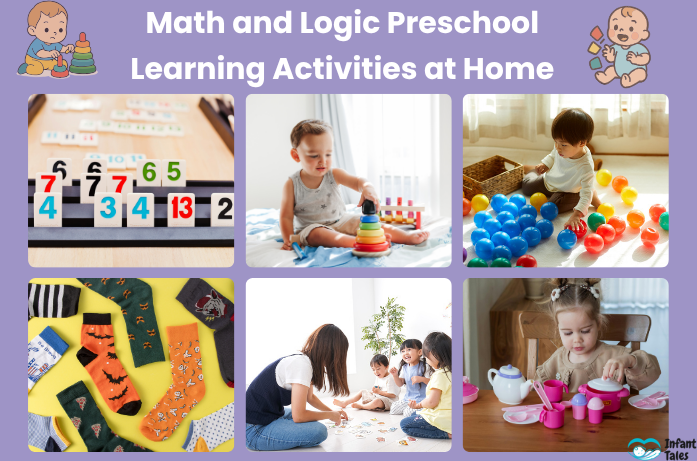
Math and Logic Preschool Learning Activities at Home
Mathematics and logic preschool learning activities are also part of the things that help in defeating the children’s opinion and arguing skills while at the same time helping them to be acquainted with numbers in their daily occurrence. The children, through their make-believe household games, have their counting, matching, and early reasoning skills strengthened.
7. Number Hopscotch
Use chalk or masking tape to draw hopscotch squares numbered 1–10. Call a number and have your child jump to that spot. This will help your child to link number learning with physical play. You can also add easy math questions like “Jump to 2 plus 1.”
8. Counting Snacks
Snack time can be used to count the number of grapes, crackers, or cereal pieces. You can also ask, “If you eat one, how many are left?” Using the actual items it makes it easier for the children to accept different number concepts.
9. Sorting by Size
Starting with the most elementary groups to the advanced ones, a selection for size sorting activity is always going to simple items like spoons, toys, or cups. Let your child sort those objects from the smallest to the largest or vice versa. Through the size activity one’s basis of early measurement skills gets firm.
10. Color Sorting Game
Use containers or bowls with small sizes and different colors and engage your child in the process of the organization of toys, blocks, or buttons by colors. This helps to organize things according to the visual color also kids get to see differences and patterns.
11. Matching Socks Game
Disorder the clean socks and then ask your child to find the matching pairs among them. It is an easy and interesting way to develop the skill of problem-solving, visual matching, and organization.
12. Memory Matching Cards
The first step would be to prepare cards with matching pictures or stickers. Then, you can place them face down and play a memory game by taking turns to flip two at a time. Such games train focus, patience, and logical reasoning in kids.
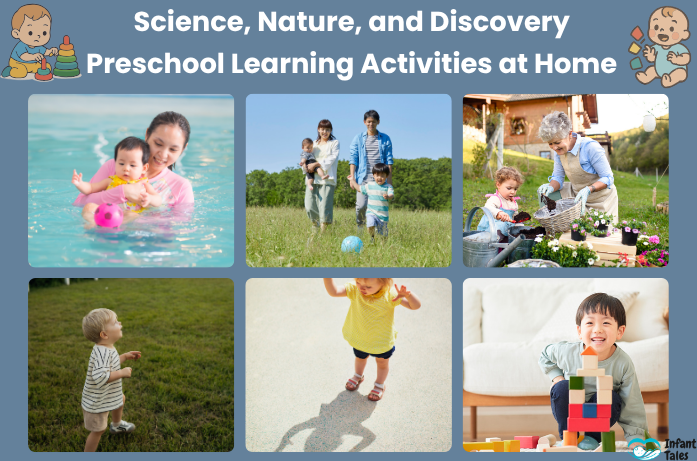
Science, Nature, and Discovery Preschool Learning Activities at Home
Science and nature preschool learning activities instigate curiosity and experiential exploration. Children through simple experiments and outdoor discoveries learn about cause and effect, observation, and the way the world works.
13. Simple Science: Sink or Float
Get a tub or basin filled with water and let your child test which objects float or sink, for instance, a spoon, toy car, or leaf. And before putting each item into the water, ask the child to guess the outcome. This activity is in the list of early preschool learning activities through which the kids develop curiosity, observation, and scientific reasoning.
(Inspired by early preschool learning activities recommended by PBS Kids)
14. Nature Walk Scavenger Hunt
Step outside and take a nice stroll around the neighborhood. Try to spot a flower, a rock, a feather, or a leaf, and write them down in a list. Persuade your child to more actively take part by having them describe and touch the things they see. This way of interaction leads to the improvement of observation powers and rich vocabulary.
15. Gardening Together
Plant seeds in small pots or in the garden. Talk about watering, sunlight, and how plants grow over time. Your child learns patience, care, and the basics of nature’s life cycle.
(Endorsed by child development experts at NAEYC)
16. Weather Watcher
Make a weather chart with symbols for sunny, rainy, or cloudy days. Each morning, observe and record the weather. It builds awareness of daily changes and encourages consistent observation.
17. Shadow Play
Do some shadow play activities with your child. Use a flashlight or the sunlight to cast shadows on a wall. Encourage your child to make animals or objects by using their hands and then guess what they are. This activity fosters creativity and the insight into the relation between light and shape.
18. Build with Blocks or Boxes
Play with blocks or boxes to make structures of your child’s choice. Give them various materials like blocks or cardboard boxes to build things like towers and bridges. By doing so, the children will improve mental acuity, as well as creativity and the dexterity needed to work with their hands.
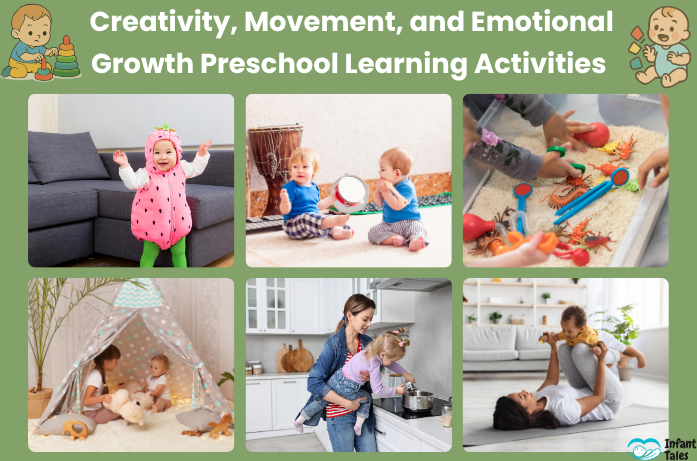
Creativity, Movement and Emotional Growth Preschool Learning Activities
Creative and movement-based preschool learning activities support emotional development, coordination, and confidence. These experiences help children express feelings, manage emotions, and explore the joy of movement and imagination.
19. Dance Party Breaks
Put on music that your child likes and dance along to it with your child. Give fun instructions like “Jump!” or “Spin!” Through dance kids are able to develop their physical coordination and listening skills as well as self-expression.
20. DIY Musical Instruments
Make simple instruments using household items, like a bottle filled with rice for a shaker or a pot and spoon for a drum. Let your child create rhythms and explore sounds, which enhances sensory and auditory learning.
21. Sensory Bin Play
Fill a bin with rice, lentils, or sand. Hide small toys or letters inside and have your child find them. This hands-on play strengthens fine motor skills, concentration, and sensory development.
(Backed by developmental insights from Zero to Three)
22. Build a Fort or Tent
Enlist the help of chairs, pillows, and blankets to create a comforting little spot. Pretend it’s a palace or a cozy nook for reading. This is an effective cognitive and social bonding tool.
23. Puzzle Time
Recommend age-appropriate puzzles for your child. Help them locate the matching pieces and provide hints to put the puzzle together. The process enhances the child’s spatial reasoning, patience, and persistence.
24. Simple Cooking Together
Ask your child to assist in slightly complicated life tasks like mixing dough or counting groceries. Discussing the reasons behind transformations affecting the ingredients. Cooking along teaches children measuring and step-following the safe way.
25. Calm Down Corner or Yoga Time
Set up a cozy area with cushions, books, and soft toys where the child can have a rest. Introduce some simple deep breathing or stretching techniques that will help them control their feelings. This action enforces the feeling of tranquility, awareness, and emotional equilibrium.
Everyday Learning Moments
Daily chores like folding laundry, cooking dinner, or taking a short evening walk can become powerful learning opportunities. These simple routines teach responsibility, coordination, and observation skills in a natural way.
Encourage your preschooler to help with small tasks and guide them gently. When learning feels like play, it nurtures curiosity, independence, and a lifelong love for discovery, all while you enjoy meaningful moments together.
Final Thoughts
Preschool learning activities at home doesn’t need to be complicated or expensive. The best lessons often come from simple moments of connection, reading a story together, counting snacks, or dancing in the living room. Every small interaction helps your child grow curious, confident, and creative.
Remember that consistency and love are even more important than perfection. When you work with your child’s interests and you make learning games, you are not just enriching his knowledge, but also creating a cheerful environment for his never-ending curiosity in life.
Frequently Asked Questions (FAQs)
1. What is the best age to start home preschooling programs?
Start with easy and fun daily activities regarding ages 2–3, according to the likes of your child.
2. How long should learning time be?
About 20–30 minutes daily is enough, keep it fun and flexible.
3. Do I need special materials?
Not at all, you can use very common materials such as paper, vessels, and building blocks!
4. What if my child loses interest?
This is normal, take rests or change the activities in order to keep it fun always.
Disclaimer: This is an educational article and it should not replace the professional or medical advice. Ensure the safety of children when they are playing, particularly regarding water, food, or small objects.
Looking for more creative ways to help your child grow through play? Visit our article on Preschool Learning Activities for Fine Motor Skills to find playful, skill-building ideas that make learning feel like an adventure.
